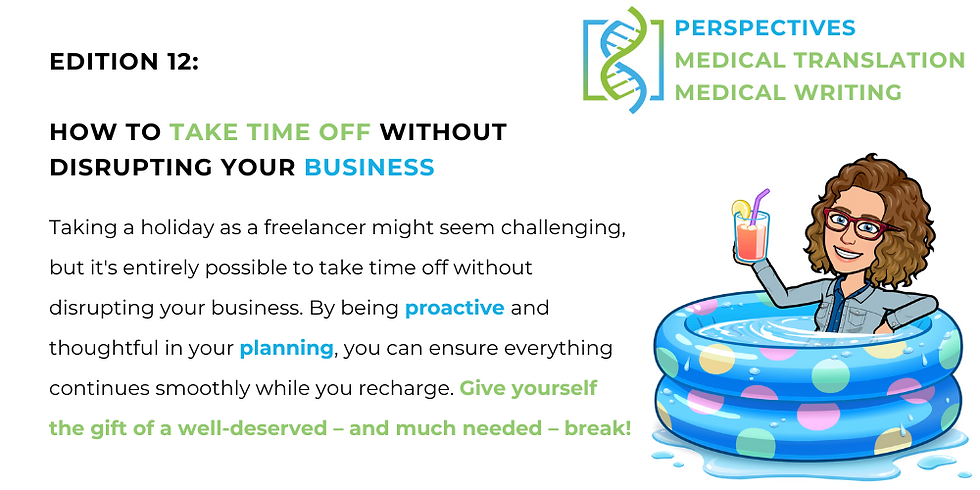How to freelance through the summer without losing clients (or your mind)
- Ana Sofia Correia

- Jun 25
- 4 min read

Summer hits differently when you’re a freelancer. Some of us are fully booked and powering through. Some are logging off for a proper break. Many are doing a bit of both – and trying not to lose momentum (or their sanity) in the process.
In medical translation and writing, summer rarely means things stop. If anything, the mix of quiet inboxes and urgent, last-minute requests makes this season more unpredictable than most.
Whether you’re staying available or stepping away, here’s how to keep your work – and your energy – in balance this summer.
Working through the summer? Let clients know you're available
If you’re keeping your usual schedule (or close to it), don’t assume clients know that. Summer often comes with radio silence, and many clients will assume you’re off unless you say otherwise.
A short message does the job:
“Just a quick note to say I’ll be working throughout July and August, so feel free to reach out if anything comes up over the summer.”
Be clear about your availability and the types of projects you’re best positioned to take on. You’re not committing to everything – just staying on the radar.
This kind of proactive communication builds trust, especially for clients managing tight timelines, summer launches, or last-minute updates while their internal teams are short-staffed.
Planning to take time off? Start by backplanning
If you’re logging off for a proper break, think beyond your travel dates. Your time off starts well before your out-of-office message goes up – and your prep should too.
(Need a refresher on how to set boundaries and prep for your break? Here’s a guide on how to take time off without disrupting your business.)
Work backwards:
When will you stop accepting new projects?
What must be delivered before you go?
What kind of follow-up might pop up while you’re away?
Keep clients in the loop (more than once)
Even your most organised clients won’t remember your holiday unless you remind them.
Send a short message 3–4 weeks ahead, then a follow-up the week before. It doesn’t need to be formal:
“Just a heads-up that I’ll be away from X to Y – let me know if anything needs to be prioritised before then!”
This gives clients a chance to plan around your time off – or move that “not urgent” job forward. And if you’re fully booked ahead of your break, say so early – it helps everyone adjust.
Expect the unexpected
There’s always a project that boomerangs. A client you haven’t heard from in months suddenly resurfaces with a “quick edit.”
A training module you localised in March needs urgent updates. A brochure you developed in May? Now it’s back from revision and ready for the final check.
Rather than hoping those jobs don’t resurface while you're packing, take 10 minutes to scan your inbox for paused threads or loose ends. Check in. Clarify timelines. Suggest wrapping things up early.
Even if nothing comes of it, it shows you’re thinking ahead – and that always lands well.
Add extra buffer (even if you’re working)
Summer has its own pace. Clients are slower to reply. Reviewers are away. Final approvals can drag out.
That “quick turnaround” might become a bottleneck if just one person in the chain is out.
So, whether you’re taking time off or working straight through, pad your timelines. Don’t rely on everyone being available. Give yourself room for slow replies – and unexpected changes.
Let your out-of-office work for you
When you log off, make your out-of-office message as helpful as possible – for your clients and for yourself.
Include your return date
Say whether you’ll be checking email (or not)
Offer a referral or backup contact if relevant
Set expectations for when they’ll hear back
And most importantly: You don’t need to be reachable. You’re allowed to actually rest.
“I’ll be away from X to Y and not checking email. I’ll get back to you after I return. Thanks for your patience!” – Short, kind, and clear.
Coming back? Ease into it
Getting back to work after a break can feel like a rude awakening – especially if your inbox is full and your to-do list picked up speed while you were away.
Instead of jumping straight into high gear, give yourself space to land:
Block out a catch-up day (or two) to handle email, admin, and project planning
Focus on what actually needs doing first – let the rest wait
Reconnect with clients: “Hope you’ve had a good summer! I’m back and getting up to speed this week – let me know what’s on your radar.”
If you gave yourself buffer time after your return (well done, past you!), use it to find your rhythm again – not to sprint from day one.
Returning doesn’t have to mean overcompensating. It just means showing up with clarity and energy – which is exactly what time off is for.
Protect your energy, not just your schedule
Whether you're working, resting, or somewhere in between, summer is the perfect time to pause and ask: What pace actually works for me right now?
You don’t have to follow what everyone else is doing. Some years, you work through. Others, you take a proper break. Either way is valid – as long as it's a conscious choice.
Planning doesn’t have to be perfect. But it needs to protect your time, energy, and attention – because those are your most important tools.
Summer doesn’t have to be all-or-nothing. You can be available without being overwhelmed. You can slow down without disappearing. And most importantly, you can run your business in a way that works for you – even in July and August.






